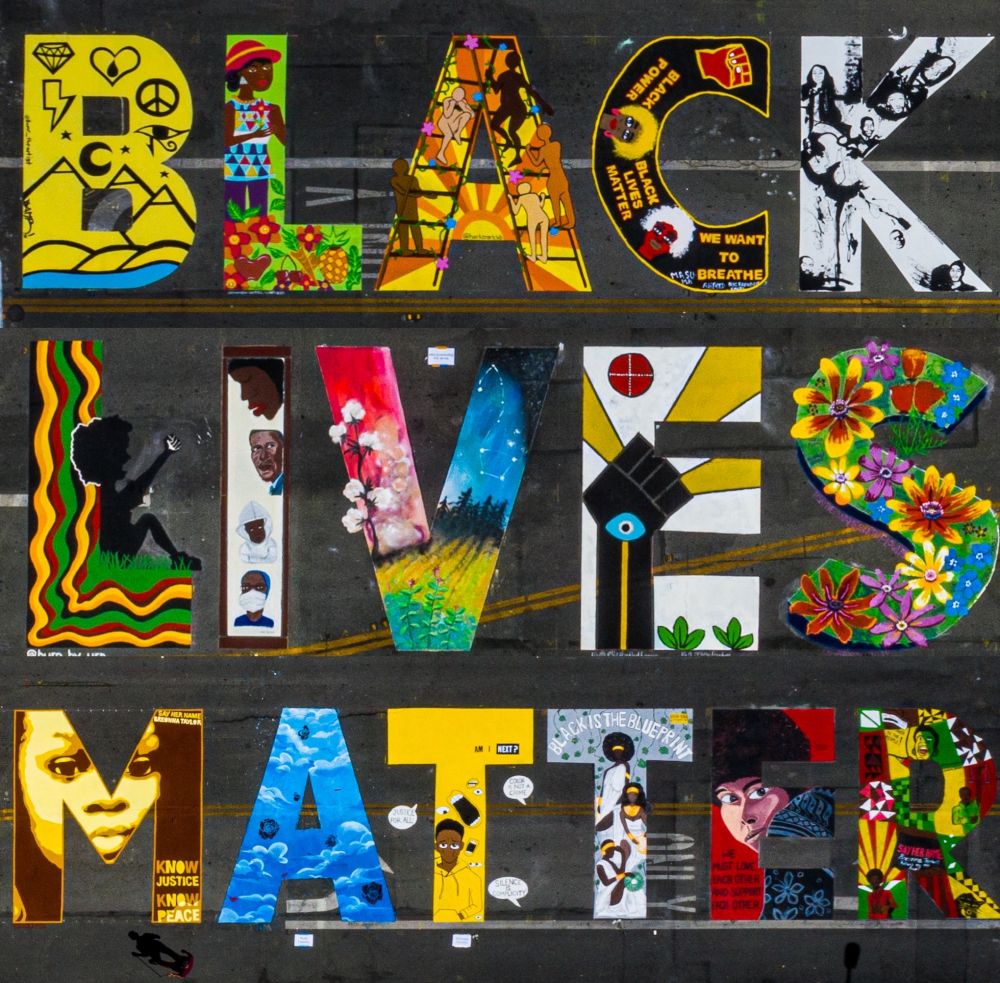
For eight artists who contributed to Palo Alto’s Black Lives Matter mural this summer, the project was one example of the power public art has in bringing communities together, fostering conversations and amplifying racial equity initiatives.
The creatives from all over the Bay Area came together for a virtual panel discussion hosted by Palo Alto’s Public Art Program on Thursday, Sept. 10.
The event was part of the city’s ongoing effort to address systemic racism and bias in the city.
Palo Alto Public Art Commission Chair Ben Miyaji and Commissioner Nia Taylor hosted eight of the 16 artists who painted the Black Lives Matter mural painted June 30 outside of Palo Alto City Hall. Elizabeth Foggie, Adam Amram, Stuart Robertson, Urna Bajracharya, Masuma Ahmed, Shiraaz Bhabha, Sarah Joy Espinoza-Evans and Briena Brown explained why they joined the project, talked about their experience and discussed their hopes for how the mural and other works of public art may have an impact.
For most, interest in working on the mural was both personally and politically motivated.
What’s local journalism worth to you?
Support Palo Alto Online for as little as $5/month.Learn more
“About a year ago I was stopped by three police officers in a van while riding my bike, enjoying the sun on my skin,” Foggie, a former Cubberley Artist Studio Program participant, recalled. “When I heard about this call (for the mural) I was like, ‘Oh, wow. OK.’ I feel like this is coming full circle. It was a way for me to begin to process more of that experience, which was extremely traumatic for me.”
Robertson, a native of Jamaica who received his master of fine arts degree at Stanford University in June, said that as protests erupted over police brutality and racism, he felt “sort of paralyzed and crippled to not be able to go out and do certain things; mindful of my role as a Black male in this society, trying to avoid interactions with the police.”
The mural was a “very appropriate way to get involved” and also drew on his experience as an art teacher and his work with youth.
Bajracharya applied to be part of the project specifically because it was happening in Palo Alto, home to the affluent and powerful, she said. After fellow artist Cece Carpio’s portrait of Black Liberation Army activist Assata Shakur (included in one of two letter E’s) generated controversy, Bajracharya said it was “disappointing to see how little the Palo Alto community tried to discover her (Shakur’s) side of the story.”
Espinoza-Evans said she grew up not knowing much about her racially mixed heritage. Working on the mural was an extremely emotional experience for her, as she was also learning about her own family’s history. She also drew on her past role as an art teacher in East Palo Alto.
Stay informed
Get daily headlines sent straight to your inbox.Sign up
“I wanted to work on this mural to help give a voice to some of the students I worked with who didn’t really have a voice,” she said.
Taylor, who co-led the initiative along with former Commissioner Aly Richter, called the mural by far “the most exciting opportunity that I have had on the commission.” Calling to mind the discussions sparked by the mural, she asked the panelists to describe their “call to action” or hopes moving forward.
San Jose State University student Briena Brown, among others, called for local communities and especially tech companies to be proactive about becoming aware of biases, tackling system racism and supporting people of color, in the arts and otherwise.
“Facebook needs to withdraw its funding from the Menlo Park Police Department immediately,” she said, citing injustice on the part of Menlo police officers.
Foggie said: “I also want to see more Black artists get more money. I want to see more of them and more of them get more money.”
Most Viewed Stories
■ Facing a lawsuit, Palo Alto plans to permanently expand Foothills Park access
■ Bay Area’s new growth plan eyes massive housing influx in Silicon Valley
■ Excessive slang? Palo Alto seeks dismissal of lawsuit from violent Happy Donuts arrest
■ Electronics go missing in overnight home burglary as couple slept
■ City Council incumbents retain cash edge as Election Day looms
Robertson agreed and mentioned the stark divide between Palo Alto and East Palo Alto as highly problematic.
“Pay people. Pay artists. Find them and support them. We can’t do this work if we’re not fed,” he said, adding that artists would be willing to make bolder work and take more risks if they were more financially secure.
All of the panelists agreed that working on public art — as opposed to gallery or studio art — is a special experience and can have a real impact on a community.
When art pops up in public spaces, Foggie said, it disrupts people’s everyday numbness to the world around them.
“Black Lives Matter echoing in the space of Palo Alto is important, especially when we expect the public to go out and internalize that message,” Amram said, noting that one of the reasons he was interested in the project was the mural’s controversial positioning in front of City Hall.
“Police would have to contend with that message on the day-to-day. I thought that was important whether it worked out or not. It engages people in a much different way.”
Ahmed was especially gratified by the way in which this project — and public art in general — can foster collaboration and community involvement.
“Public art is much more powerful in bringing people together,” she said.
“I had a lot of really productive conversations for weeks after the mural,” Brown said. “The first step in racial equity initiatives is the desire to understand another’s perspective. Art is a great tool for amplifying this movement.”